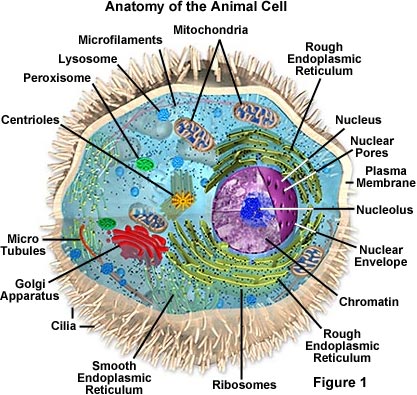
Animal cells are typical of the eukaryotic cell, enclosed by a plasma membrane and containing a membrane-bound nucleus and organelles. Unlike the cells of the two other eukaryotic kingdoms, plants and fungi, animal cells don't have a cell wall. This feature was lost in the distant past by the single-celled organisms that gave rise to the kingdom Animalia
Eukaryotic cells are typically much larger than prokaryotes. They have a variety of internal membranes and structures, called organelles, and a cytoskeleton composed of microtubules, microfilaments, and intermediate filaments, which play an important role in defining the cell's organization and shape. Eukaryotic DNA is divided into several linear bundles called chromosomes, which are separated by a microtubular spindle during nuclear division.
The animal kingdom is unique amongst eukaryotic organisms because animal tissues are bound together by a triple helix of protein, called collagen. Plant and fungal cells are bound together in tissues or aggregations by other molecules, such as pectin. The fact that no other organisms utilize collagen in this manner is one of the indications that all animals arose from a common unicellular ancestor.
*
cytoplasm
A transmission electron micrograph of the cytoplasm of a plant cell. M = mitochondrion; V = vacuole; G = Golgi apparatus ; W = cell wall; P = plastid; ER = endoplasmic reticulum. Image credit: Donald Dandforth Plant Science Center
The jelly-like matrix that surrounds the nucleus of a cell and is bounded by the cell membrane. It includes the organelles of the cell as well as the sugars, amino acids, and proteins that the cell uses for growth and reproduction. Cytoplasm was formerly referred to as protoplasm. The portion of the cytoplasm that lies outside organelles and includes other insoluble cellular components is called cytosol.
Centrioles - Centrioles are self-replicating organelles made up of nine bundles of microtubules and are found only in animal cells. They appear to help in organizing cell division, but aren't essential to the process.
*
Cilia and Flagella - For single-celled eukaryotes, cilia and flagella are essential for the locomotion of individual organisms. In multicellular organisms, cilia function to move fluid or materials past an immobile cell as well as moving a cell or group of cells.
*
Endoplasmic Reticulum - The endoplasmic reticulum is a network of sacs that manufactures, processes, and transports chemical compounds for use inside and outside of the cell. It is connected to the double-layered nuclear envelope, providing a connection between the nucleus and the cytoplasm.
*
Golgi Apparatus - The Golgi apparatus is the distribution and shipping department for the cell's chemical products. It modifies proteins and fats built in the endoplasmic reticulum and prepares them for export to the outside of the cell.
*
Lysosomes - The main function of these microbodies is digestion. Lysosomes break down cellular waste products and debris from outside the cell into simple compounds, which are transferred to the cytoplasm as new cell-building materials.
*
Microfilaments - Microfilaments are solid rods made of globular proteins called actin. These filaments are primarily structural in function and are an important component of the cytoskeleton.
*
Microtubules - These straight, hollow cylinders, composed of tubulin protein, are found throughout the cytoplasm of all eukaryotic cells and perform a number of functions.
*
Mitochondria - Mitochondria are oblong shaped organelles that are found in the cytoplasm of every eukaryotic cell. In the animal cell, they are the main power generators, converting oxygen and nutrients into energy.
Mitochondria have two functionally distinct membrane systems separated by a space: the outer membrane, which surrounds the whole organelle; and the inner membrane, which is thrown into folds or shelves that project inward. These inward folds are called cristae. The number and shape of cristae in mitochondria differ, depending on the tissue and organism in which they are found, and serve to increase the surface area of the membrane.
*
Nucleus - The nucleus is a highly specialized organelle that serves as the information and administrative center of the cell.
The nucleus is spheroidal in shape and separated from the cytoplasm by a double-membrane structure called the nuclear envelope. The nuclear envelope isolates and protects a cell's DNA from various molecules that could accidentally damage its structure or interfere with its processing. During processing, DNA is transcribed, or synthesized, into a special RNA, called mRNA. This mRNA is then transported out of the nucleus, where it is translated into a specific protein molecule. In prokaryotes, DNA processing takes place in the cytoplasm. Inside the nucleus of eukaryotes is the nucleolus.
*
Peroxisomes - Microbodies are a diverse group of organelles that are found in the cytoplasm, roughly spherical and bound by a single membrane. There are several types of microbodies but peroxisomes are the most common.
*
Plasma Membrane - All living cells have a plasma membrane that encloses their contents. In prokaryotes, the membrane is the inner layer of protection surrounded by a rigid cell wall. Eukaryotic animal cells have only the membrane to contain and protect their contents. These membranes also regulate the passage of molecules in and out of the cells.
*
Ribosomes - All living cells contain ribosomes, tiny organelles composed of approximately 60 percent RNA and 40 percent protein. In eukaryotes, ribosomes are made of four strands of RNA. In prokaryotes, they consist of three strands of RNA.
Three main protein systems constitute the cytoskeleton. These are, in order of typical abundance:
* Microfilaments
* Intermediate filaments
* Microtubules
A three-dimensional network of fibers, composed of filamentous protein, which runs throughout the matrix of living cells, providing a framework for organelles, anchoring the cell membrane, and providing a suitable surface for chemical reactions to take place. The cytoskeleton also provides the cell with motility – the ability of the entire cell to move around and for material to be moved within the cell
No comments:
Post a Comment